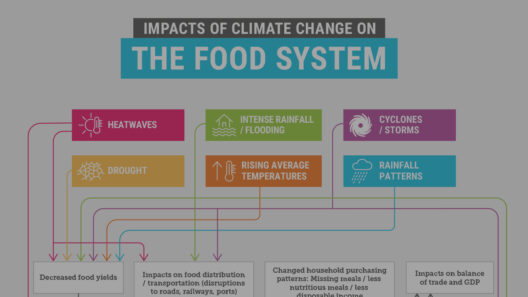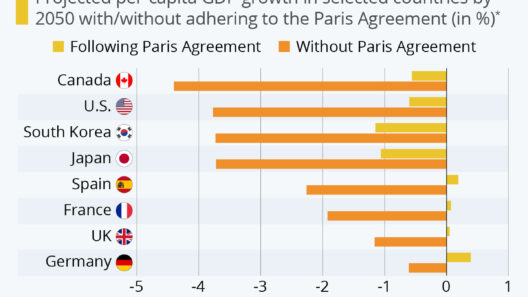The Paris Climate Agreement stands as a monumental endeavor in the global quest to combat climate change. Like a ship set adrift on a tumultuous sea, the agreement represents the collective aspiration of nations to navigate through the uncharted waters of environmental degradation and forge a sustainable future. Launched in December 2015 during the 21st Conference of the Parties (COP21) in Paris, France, this accord aims to bring together countries worldwide to combat the existential threat posed by climate change.
At its core, the Paris Agreement seeks to limit global warming to well below 2 degrees Celsius above pre-industrial levels, with an aspirational goal of capping the temperature increase at 1.5 degrees Celsius. This target is not merely a numerical aspiration but a clarion call for urgent action. Each fraction of a degree carries significant implications for ecosystems, human health, and socioeconomic stability. The intent is to prevent the catastrophic downpour of climate-induced disasters that threaten our very existence.
Central to the agreement is the principle of ‘nationally determined contributions’ (NDCs). Unlike previous accords, which often imposed legally binding targets upon nations, the Paris Agreement adopts a more flexible, bottom-up approach. Each country is responsible for formulating its own climate action plan, tailored to its specific circumstances and capabilities. This inclusive framework allows for a diverse array of strategies, recognizing that one size does not fit all in the climate action tapestry.
However, this confessing flexibility does come with its own intricacies. The success of the Paris Agreement hinges on the sincerity and ambition behind each country’s NDC. Nations are urged to submit and update their commitments every five years, a mechanism designed to foster accountability and ambition over time. The hope is that, much like a gardener nurturing plants, countries will be inspired to cultivate their contributions, leading to a bountiful harvest of emissions reductions.
Financial support also plays a crucial role in this global initiative. For developing nations, transitioning to sustainable economies often presents formidable challenges. Thus, affluent countries have pledged to provide $100 billion annually by 2020 to assist in mitigating the impacts of climate change and to foster adaptation and resilience strategies. This financial assistance is not merely altruistic; it serves to illuminate the path for developing nations, ensuring they are equipped with the tools and resources necessary to join the fight against climate change.
Monitoring and accountability mechanisms are another cornerstone of the Paris Agreement. The implementation of the ‘mutual accountability’ system fosters trust among nations. Through a transparent reporting process, countries must regularly share their progress toward achieving their NDCs. This fosters a sense of shared responsibility, akin to a choir harmonizing their notes, producing a unified sound that resonates with the urgency of climate action.
As the landscape of climate politics continues to evolve, collaboration and inclusivity remain paramount. The Paris Agreement not only recognizes the pivotal role of state actors but also the contributions of non-state actors, including cities, businesses, and civil society organizations. This multi-faceted approach acknowledges that combating climate change requires a collective societal effort, akin to weaving a robust tapestry where each thread signifies a unique entity’s contribution.
Despite the optimism that the Paris Agreement engenders, challenges remain formidable. The pathway ahead is riddled with obstacles, from political resistance to economic constraints, and from the inertia of entrenched fossil fuel industries to the tumultuous repercussions of climate misinformation. The ascent to a sustainable future demands unwavering resolve and collaborative vigor. Each incremental progress nudges the world closer to mitigating the dire consequences of climate change.
Moreover, the palpable urgency for action is exemplified by the mounting evidence of climate change impacts. From unprecedented wildfires and formidable hurricanes to escalating sea levels and biodiversity loss, the harbingers of climate change serve as constant reminders of the stakes at hand. The ink on the Paris Agreement may have dried, but the urgency of the commitments inscribed within its pages only amplifies.
In contemplating the efficacy of the Paris Agreement, one must remain vigilant in distinguishing between mere rhetoric and tangible action. The agreement serves not just as a legal instrument but as a catalyst for change, a beacon of hope against the backdrop of climate nihilism. Just as a lighthouse guides ships to safety amidst turbulent waters, the Paris Agreement illuminates the path forward, urging nations to act with resolute purpose and unwavering commitment.
The horizon holds promise, but it demands diligence. Stakeholders at every level—from policymakers to citizens—must galvanize efforts to ensure that the visions set forth in the Paris Agreement are not relegated to mere words. The very fibers of our existence depend upon our ability to harmonize our efforts and act decisively in the face of adversity.
In conclusion, the Paris Climate Agreement represents a symphony of global cooperation, an acknowledgment that climate change is a mutual challenge that transcends borders. With collective action and unwavering resolve, the international community possesses the potential to steer the world toward a more sustainable and equitable future. The harmony of these collective efforts holds the promise of not just surviving climate change but thriving in a world where nature and humanity coexist harmoniously.




